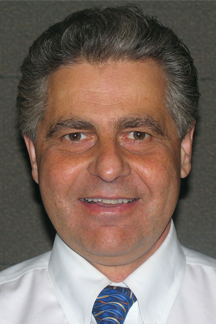Team Wins $13 Million Grant in AIDS Vaccine Effort
By Madeline McCurry-Schmidt
A team led by scientists at The Scripps Research Institute (TSRI) and International AIDS Vaccine Initiative (IAVI) has received a grant of more than $13 million from the National Institute of Allergy and Infectious Disease of the National Institutes of Health to study antibodies to the human immunodeficiency virus (HIV)—which will play an essential role in the creation of any effective vaccine against HIV.
Richard Wyatt, a TSRI professor of immunology and director of viral immunology for the IAVI's Neutralizing Antibody Center at TSRI, will be the principal investigator for the five-year study.
“The long-term goal is to elicit broadly neutralizing antibodies against HIV,” said Wyatt. “This is a difficult task because of the variability of the virus.”
Researchers have worked toward an effective HIV vaccine since the virus was isolated in 1983, but this has been challenging because HIV’s unusual structure helps it evade the immune system and scientists’ attempts to harness the body’s defenses.
A small minority of infected people, however, do show an effective immune response to the virus. The B cells in their immune systems produce antibodies that can neutralize a wide range of HIV strains. Though this does not stop their infections from establishing in their own body, these broadly neutralizing antibodies (bNABs) do neutralize most circulating viruses and could help researchers design an effective vaccine.
This project, titled “High Resolution Analysis of Env-directed B Cells to Accelerate Vaccine Design,” will focus on generating antibodies to the virus and assessing their neutralizing capacity. Finding vaccine-elicited bNABS would be a positive step toward an effective HIV vaccine.
To be successful, Wyatt and his colleagues ultimately hope to find additional rare bNABs that can navigate some of HIV’s defensive obstacle course, determine how they do that and use that information to generate even more effective antibodies.
One of the biggest challenges for bNABs is to get past an outer layer of sugars, called glycans, which act as a “shield” to disguise the virus and block immune cells from attacking it, Wyatt said.
Another challenge is to take advantage of a stable site on the virus’s outer structure. HIV constantly mutates and changes shape, but there is one site where the virus stays the same in order to bind to a cell surface receptor protein, called CD4, present on some specialized human cells.
“The virus first has to bind to CD4, then it uses its other co-receptor to get its RNA—the genetic material—into the cell,” said Wyatt.
If Wyatt and his co-investigators can block the virus with a bNAB at that site, they could stop HIV from spreading its genetic material and establishing an infection.
To define the best means to elicit neutralizing antibodies following vaccination, Wyatt and his group are working with an international team. Co-investigators at the Karolinska Institutet in Stockholm will first immunize animals with viral surface proteins engineered in the Wyatt lab. These proteins resemble the virus, and they could prompt an immune response in the animal models. Next, the Karolinska group will analyze this immune response at the molecular level.
Wyatt’s team will then analyze the blood serum samples for the presence of neutralizing antibodies, with the ultimate goal of eliciting bNAbs.
If and when the serum analysis shows signs of elicitation of neutralizing antibodies, TSRI Assistant Professor Yuxing Li will lead an effort to isolate the antibodies and then use a technique called epitope mapping to see exactly how the antibodies interact with the virus. She will collaborate with researchers at TSRI and Colombia University to study the antibodies at an atomic level by using imaging techniques called electron microscopy and X-ray crystallography.
“Now is the time to really impact the field with the next generation of surface proteins, or immunogens, that induce a broadly effective immune response to HIV,” said Li.
With this information, researchers hope they will someday contribute to vaccines that stimulate a protective, virus-neutralizing response.
The number of the grant is 1P01AI104722.
Send comments to: press[at]scripps.edu














